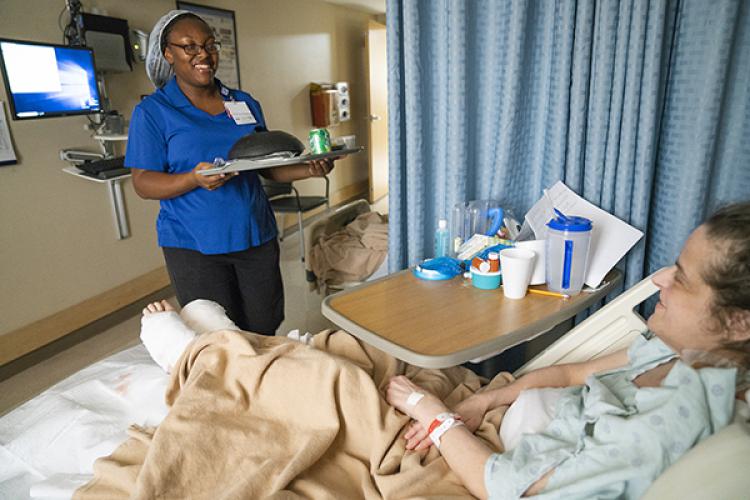
At first glance, the job of the folks who deliver meals to patients in their rooms seems pretty straightforward – drop off the food tray and pick it up when the patient has finished eating.
But people who work as Dining Service Associates at John Peter Smith Hospital know that their role is so much more. A warm smile and a bit of conversation with a Dining Service Associate can be the best moment of a patient’s day when they are feeling sick and longing for home.
“They may be the only person that goes in the patient’s room who won’t poke them, prod them, ask them to give blood or give them bad news,” says JPS Executive Chef Chris Gilbert. “They are there to give service with a smile and give good, hot food. It can be a very simple thing, but it can also be a very important thing on one of the most complex days of their lives.”
Dining service associates are trained to provide courteous, helpful service, visiting patients in their rooms to serve the meal tray, offer extra condiments and collect the patient’s menu choices for the next day.
At mealtimes, Dining Service Associate Symone Buckles pushes her cart from the kitchen on the Lower Level to the green elevators, riding to her assigned units in the Patient Tower. A bag hangs from the cart with pouches for condiments and small pencils patients use to fill out menus.
Before entering each patient’s room, Buckles cleans her hands with a squirts of hand sanitizer, then knocks and enters. She introduces herself and double checks the patient’s name and birthdate to confirm she is giving the right tray to the right patient.
Patient Julie LaHaie, who had been hospitalized about a month, says she looks forward to mealtimes and appreciates that they always have a smile.
“It is nice to see a friendly face,” LaHaie said.
Before leaving the room, it’s important to take a moment to check in with the patient and ask if there is anything they need, Buckles says.
Some patients ask for a blanket or to adjust the room temperature. A patient may ask for help reading the menu. That may be due to literacy challenges or because they don’t have their glasses with them at the hospital.
Buckles sometimes fills out the card for the patient because of injuries to their hands or arms.
And sometimes patients are not familiar with a particular dish and will ask Buckles to describe it to make sure they will like it or that it conforms to religious requirements.
Dining service associates can get to know patients who are hospitalized regularly or for long periods, says Chasity Kennard, who has been on the job for more than a year.
“You can sometimes tell if a patient hasn’t had a visitor in a while. They look sad,” Kennard says. “I understand that people need to feel like somebody cares. They are happy to see you. When they see me, they start smiling.” Kennard said.
